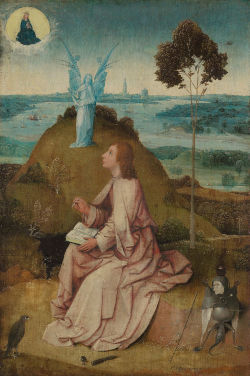Revelation
I. Introduction

St. John on Patmos
by Hieronymous Bosch
Many people keep the book of Revelation at arms length, considering it too strange, esoteric and downright frightening. Yet, should we assume the book is so foreign that we should fear its imagery or its unusual contents? I think not.
As a Christian prophet, John of Patmos wrote the book of Revelation in a sub-genre of Jewish literature called "apocalyptic eschatology." Apocalyptic merely meant divine revelation; eschatology was the study of the end times. True, the book was unique but not because it stood alone. It existed as one among dozens and dozens of apocalyptic works penned from 200 BCE into the Middle Ages. No, authorship and context made it one-of-a-kind. Instead of claiming the authority of an ancient figure through pseudography, the author wrote in his own name, depending upon his own standing among his audience. And, as far as we know, he was the first to write such a work for a Christian audience.
To understand the intent of John and his word-images, we must pinpoint the date of authorship and consider the structure of the work, then we can unpack the text.
